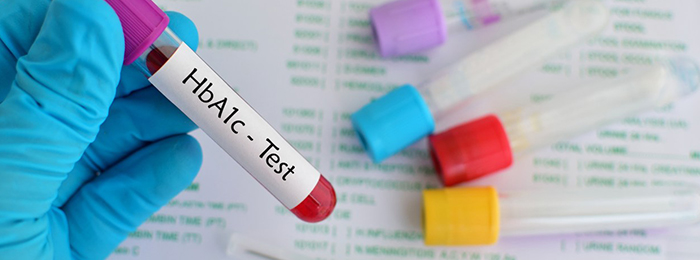Why the HbA1c testing?
We are all aware that the main problem faced by patients with diabetes is to keep their blood sugar levels under control, throughout the day and day after day. How do we know that the blood sugar level is under control? The simplest way would be to check the blood sugar levels either in a lab or using a glucose meter. However, blood sugar levels do not remain constant throughout the day and can vary from day to day and between different times of the same day. Therefore, blood sugar levels checked once or twice a day will not give a sufficiently accurate idea of the diabetes control, even if the tests are done frequently. This is why we need a test that will assess diabetes control over a longer period of time.
The glycated haemoglobin (HbA1c) testing is an index of diabetes control over the 2 to 3 months preceding the test. It is a simple and effective tool for diabetes monitoring. Higher the HbA1c level the worse has been the control over the preceding 2 to 3 months, and higher the risk of heart, kidney, nerve, and eye damage.
What is HbA1c?
HbA1c is formed when glucose gets attached to the haemoglobin found in the red blood cells (RBC) of our blood. The proportion of haemoglobin that has glucose attached to it depends on the average blood sugar levels to which the RBC has been exposed to during its lifespan (usually 120 days). Therefore the HbA1c level is an accurate measure of blood sugar levels over the past 2 to 3 months.
Importance of HbA1c Testing
Many large studies from different parts of the world have shown that diabetes complications can be prevented or delayed by keeping the blood sugar levels under control. HbA1c is a useful tool to assess whether these targets are being met. For most people with diabetes, the HbA1c target is <7%. For elderly patients or those with other serious illnesses, the target can be relaxed to <8%. Younger individuals and those with recently detected diabetes can strive for more stringent targets (e.g. <6.5%).
People with diabetes who have an HbA1c level higher than 8% need to work with their healthcare provider to change their treatment plan. When the HbA1c level is less than 7%, the treatment plan is probably working, and the blood sugar is likely under reasonable control.
A healthy person usually has an HbA1c level between 4-6%. If you have not yet been diagnosed with diabetes and you happen to find that your HbA1c level is more than 6.5%, further testing is needed to rule out diabetes.
What are the advantages of HbA1c testing?
Long-term picture
As mentioned above, HbA1c level indicates the diabetes control status over the last 2 to 3 months. Unlike the blood sugar level, the HbA1c does not fluctuate from day to day. Therefore, doctors find it easier to determine the long-term effects of therapy based on your HbA1c report.
Fasting not required
One can test HbA1c anytime. No fasting is required before you give your blood samples.
Not affected by just administered drugs
Unlike a glucose result, the HbA1c result is not affected by medication taken before the test. So there is no need to disturb the daily schedule of medicines.
HbA1c Level is also not affected by
- Time of meal intake
- Exercise
- Emotional stress
But it should also be remembered that HbA1c is only an adjunct to, and not a replacement for, blood glucose tests.
Should I take HbA1c Testing?
All patients with diabetes should check their HbA1c regularly, preferably once every 3 months. Individuals with stable, well-controlled diabetes can test less frequently as advised by their physician. Regular testing of HbA1c ensures that one is aware of the level of diabetes control and takes the right steps to control diabetes and avoid complications.
ONE CAN LEAD A LONGER AND A HEALTHIER LIFE IF TESTED FOR HBA1C REGULARLY!


Leave a Reply